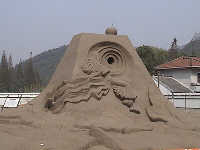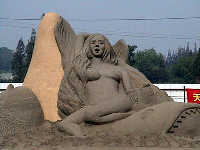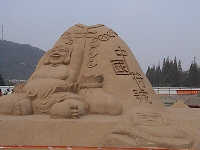| Art Q&A > Crafts | กก |
|
Sand Sculpture
Known as a modern art for only 20 years, sand sculpting is a popular and
recreational art capable of drawing widespread attention from the public. Sand
sculptures can create new tourist programmes wherever they go, bringing in
considerable commercial profits. From this point of view, the art is the result
of the perfect combination Sand sculptures can now be found in more than 100 countries and regions, especially in popular coastal cities. Sand sculptures have become one of the most popular itineraries during sea visits. Meanwhile, the art has also spread to the inland cities.
Sand
and seawater are the basic materials for sand sculptures, which are molded into
various patterns by digging, carving and hollowing out sand. Sand sculptures
contain no chemical adhesives. Once a piece of the sculpture is completed, a
special glue-water solution is sprayed over the surface to set the sculpture.
Normally, the sculpture can be preserved for several months. Since it is not
easy to preserve sand sculptures, which disintegrate over a period of time, the
art form is also known as "instant-disintegrating art".
|
||||||
 |

 A Brief Introduction to Sand Sculpture
A Brief Introduction to Sand Sculpture


 Instant-Disintegrating Art
Instant-Disintegrating Art